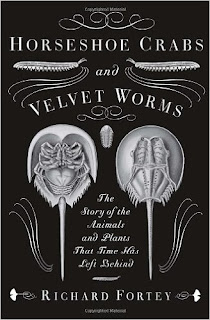Review: Horseshoe Crabs and Velvet Worms - The Story of the Animals and Plants that Time has Left Behind, by Richard Fortey
I have to begin by saying that reading this book was intensely selfish of me. Being a purely left-brained selection (non-fiction AND science!), I can't imagine that many people who read this post are going to have the same desire to pick up this book as I did, simply upon hearing the title or seeing the Ernst Haeckel drawings on the cover. It's a very niche selection, to be sure. And, actually, while we're here - Thom, if you're reading this (Thom is my roommate), you can stop now. Turn around, bright eyes, this is not a book that you would enjoy. Many fish.
That being said, reading Richard Fortey's Horseshoe Crabs and Velvet Worms turned out to be far more enjoyable than even I had anticipated. Maybe endless talk of angiosperms and blue-blooded horseshoe crabs isn't your thing, but if you're going to take a lesson on the subject, I strongly encourage you to pick up any of the prolific Richard Fortey's books. Not only will you find it an extremely rich source of information, but you may even have a good time doing so.
turned out to be far more enjoyable than even I had anticipated. Maybe endless talk of angiosperms and blue-blooded horseshoe crabs isn't your thing, but if you're going to take a lesson on the subject, I strongly encourage you to pick up any of the prolific Richard Fortey's books. Not only will you find it an extremely rich source of information, but you may even have a good time doing so.
Fortey - a paleontologist, among other things - brings an easy, pleasant sort of grandfather-scholar approach to dissecting Earth's biological tree, all the way from bacterium to humanoids; he presents history in an unfolding matter-of-fact fashion while also managing to be incredibly personable. There are a lot of scientific names and, if you either never took Latin or you sleepily skimmed through all of your biology lessons, you might think you'd find yourself in some Cretaceous weeds, but Fortey never leaves the reader without a thorough explanation.
He is, at every turn, rich in his poetic imagery, and he presents every gnarled branch in our history with an amicable humor that might make science fun even for someone less inclined to find it so. As with any effective book on the natural sciences, there are also reference pages at both ends of the book. And Fortey has arranged the chapters in such a way that you feel - all the way to the epilogue - as if you have been on this journey with the author across continents, through fields and rainforests, and deep into the past.
One cannot help but appreciate the aesthetically pleasing nature of passages like this:
See? This proves my point about Fortey's intellectual appeal: you haven't even picked up this book and already you've learned something new.
 |
| Horseshoe Crabs and Velvet Worms The Story of the Animals and Plants That Time Has Left Behind, by Richard Fortey Vintage Books | 2012 | 332 pp. |
Fortey - a paleontologist, among other things - brings an easy, pleasant sort of grandfather-scholar approach to dissecting Earth's biological tree, all the way from bacterium to humanoids; he presents history in an unfolding matter-of-fact fashion while also managing to be incredibly personable. There are a lot of scientific names and, if you either never took Latin or you sleepily skimmed through all of your biology lessons, you might think you'd find yourself in some Cretaceous weeds, but Fortey never leaves the reader without a thorough explanation.
He is, at every turn, rich in his poetic imagery, and he presents every gnarled branch in our history with an amicable humor that might make science fun even for someone less inclined to find it so. As with any effective book on the natural sciences, there are also reference pages at both ends of the book. And Fortey has arranged the chapters in such a way that you feel - all the way to the epilogue - as if you have been on this journey with the author across continents, through fields and rainforests, and deep into the past.
One cannot help but appreciate the aesthetically pleasing nature of passages like this:
Compared with human history, the seas are eternal, and the medusae pulse on and on, like an unstoppable heartbeat.Nor could one lack appreciation for the author's frank observation of the attractions of being Norwegian. Nor ignore this stinging assessment:
To give one example, the curious and venomous platypus claw always seemed to have more to do with reptiles than mammals (who, with the exception of critics, entirely lack venom).I know what you're thinking..."wait, platypodes (yes, that's the plural) are VENOMOUS?"
See? This proves my point about Fortey's intellectual appeal: you haven't even picked up this book and already you've learned something new.

Comments
Post a Comment
Any and all feedback is welcome - thanks for taking the time!